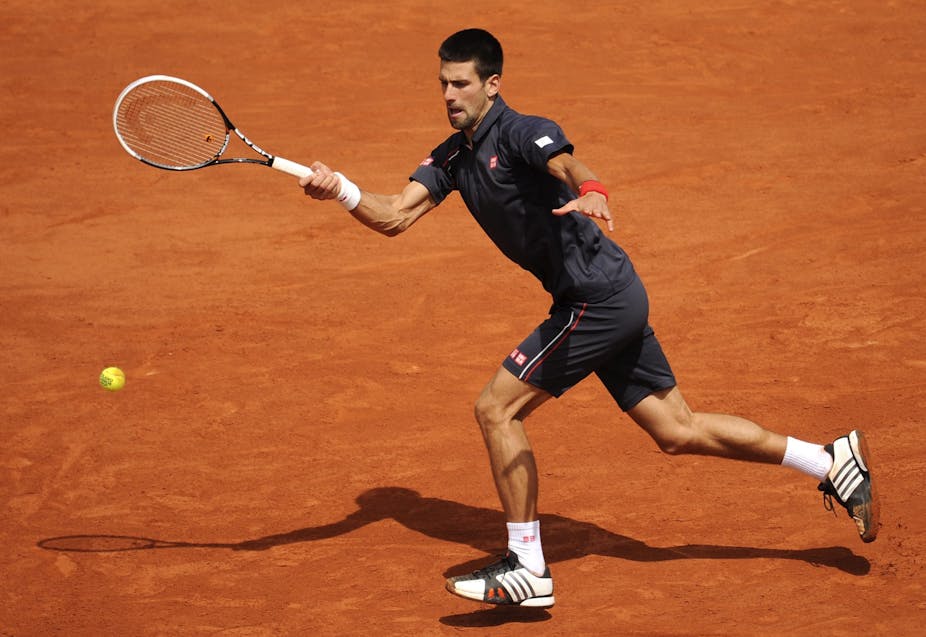Every year Melbourne plays host to the first major hard court tennis championship of the year – the Australian Open.
The blue court surfaces of Melbourne Park are now a familiar part of the Australian sporting summer, but it hasn’t always been that way.
In 2008 the courts at Melbourne Park were switched from a green Rebound Ace surface to a new, slower plexicushion surface. It was a controversial move and one that has created an advantage for some players and a disadvantage for others.
So which players might have an advantage on a slower surface? And how much of an effect does court surface have on tournament success?
Plexicushion champions
The history books show us that recent success on the plexicushion surface of Melbourne Park has gone the way of “aggressive baseliners” – players that dictate play from the back of the court with either heavy spin or flat and fast counter-punching groundstrokes.
Novak Djokovic and Serena Williams in particular have been the clear beneficiaries of the surface change, taking home five of the last ten (combined men’s and women’s) Australian Open championships.
Other players which seem to be suited to the newer Melbourne Park surface include Andy Murray, Roger Federer, Maria Sharapova and Victoria Azarenka.
These players have something in common: they’ve done extended training stints on clay courts.
Clay is king
Success on hard courts – such as those used at the Australian Open – could well be linked to prolonged training stints on clay courts. In fact, it has been suggested that more than 80% of the world’s top-ten players have spent at least half of their training lives battling it out on the red dirt.
Clay is the slowest tennis surface of them all, due to a greater amount of friction created by the ball when it hits the dirt. Constructed from either crushed shale, stone or brick, the clay surface produces a higher and slower bounce than both grass and hard courts. This pushes most players way beyond the baseline into a more defensive court position – a nightmare for most serve-reliant players.
Clay courts are also responsible for fewer knee-related injuries - due to reduced impact on joints and muscles, as well as an decreased player-to-surface friction coefficient – and fewer matches have been cut short because of injury on clay courts than at the Australian and US Open (both of which are held on hard courts).
Longer and stronger
On average, clay court rallies last longer (7-8 seconds) than those held on hard courts (6-7 seconds) and grass courts (2-3 seconds). A slower surface, combined with reduced chance of injury and increased match time, provides players with an opportunity to develop strategic fundamentals involved in tennis.
Playing on a slower surface also teaches players discipline, patience and how to effectively construct the longer points which dominate play on European dust.
The physically taxing nature of playing on clay has also been shown to produce increased physiological responses (compared with hard courts), such as:
- greater utilisation of the aerobic metabolism
- increased heart rate and blood lactate concentration
- increased energetic cost and perceptual loads.
The slower incoming ball on clay means players are also required to generate more of their own power, rather than utilising their opponent’s incoming kinetic energy to counterattack during rallies.
The combination of an enhanced exercise capacity and tolerance to prolonged match play (which is most common on clay), and a better understanding of point construction is a winning formula, not only on clay, but also on the now-slower hard courts.
Game-changer
So what does this mean for the traditional net player – the player who relies on big serves followed up with a swift move to the net, aiming to dispose of weak returns from their opponent’s racket?
The advancement in technology, especially in tennis rackets, now encourages a more all-round game style which is not only favourable, but a necessity for tournament longevity in all of the grand slams.
Barrelling aces and serve-and-volley tactics are great, and still an advantage on the faster grass court surfaces of the All England Club, where a record 113 aces were served up by John Isner in his 2010 campaign at Wimbledon.
But the gap between hard-hitting serve-and-volley-ers and aggressive baseliners is closing, and the baseliners have already made their mark on the faster grass and hard court grand slams.
One of the most prominent examples is Rafael Nadal, who is missing from this year’s Australian Open, but has proven that his clay court prowess and years of hard work on the dirt can be transferable to all surfaces in the modern game.
He has been able to mould a classical clay court game into an all-round style, potent on all of the four major surfaces, and is the first male player in tennis history to simultaneously hold grand slam titles on clay, grass and hard courts.
Clay is the way
So hard courts are getting slower, and the cream of the crop are focusing on developing sound technical and physical attributes on clay.
In this light, it makes sense that the Melbourne Park’s recent redevelopment has included the construction of eight new clay courts. This is in addition to the Australian Institute of Sport’s European training base in Italy which includes provisions for touring tennis players to gain further experience on the dirt.
It’s yet to be seen whether this will be enough to help Australian tennis players nudge into the top echelon of the sport and perhaps take the Australian Open crown in the coming years.

